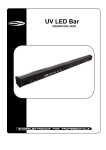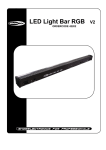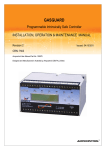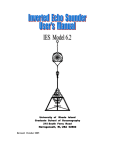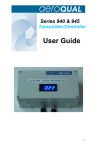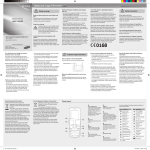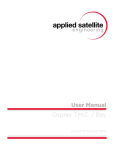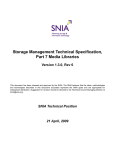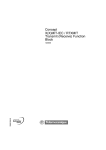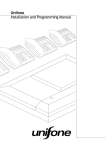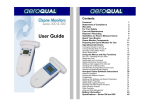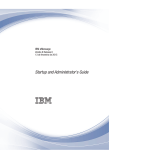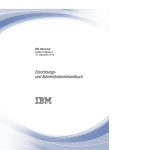Download Aquavx Scout Manual
Transcript
Aquavx Scout Remote monitoring and alarm notification system User’s Manual Version 1.1 December 1, 2009 1 INTRODUCTION ................................................................................................................. 1 1.1 GENERAL OPERATION ........................................................................................................... 1 1.1.1 Acknowledging Alarms .......................................................................................... 1 1.1.2 Store and Forward Buffer ...................................................................................... 1 2 INSTALLATION ................................................................................................................... 3 2.1 ENABLING POWER ................................................................................................................ 7 2.2 SIM CARD INSTALLATION ON A GSM PHONE ............................................................................. 8 2.3 GSM SIGNAL STRENGTH AND REGISTRATION ............................................................................. 8 3 NAVIGATING THE MENU .................................................................................................... 9 3.1 KEYPAD AND NAVIGATING THE MENUS .................................................................................. 10 3.2 MENU STRUCTURE ............................................................................................................. 11 4 OPERATOR LOGIN/LOGOUT ............................................................................................. 12 5 VIEWING CHANNEL DATA ................................................................................................ 13 6 VIEWING ALARMS AND GSM STATUS ............................................................................... 15 7 VIEWING THE HOME SCREEN ........................................................................................... 17 8 ARMED AND DISARMED .................................................................................................. 18 9 USER‐DEFINED KEYS ......................................................................................................... 19 10 VIEWING ALARM HISTORY ............................................................................................... 20 11 VIEWING EVENT HISTORY ................................................................................................ 21 12 SCROLLING CHANNEL STATUS .......................................................................................... 22 12.1 PROGRAM A CHANNEL TO BE INCLUDED IN THE SCROLLING SCREENS ............................................ 22 12.2 SCROLLED CHANNELS .......................................................................................................... 22 13 MANUALLY CONTROLLING RELAYS ................................................................................... 23 14 PROGRAMMING FROM THE KEYPAD ................................................................................ 24 14.1 HOW TO READ THE PROGRAM SCREEN .................................................................................. 24 14.2 SITE SETUP ....................................................................................................................... 25 14.3 PUMP SETUP .................................................................................................................... 27 14.3.1 Pump Parameters ................................................................................................ 28 14.4 GSM SETUP ..................................................................................................................... 29 14.4.1 GSM Parameters .................................................................................................. 30 14.5 FTP SETUP ....................................................................................................................... 31 14.5.1 FTP Parameters ................................................................................................... 32 14.6 SERIAL PORTS 1 & 2 SETUP .................................................................................................. 33 14.6.1 Serial Port Parameters ......................................................................................... 34 14.7 CHANNEL SETUP ................................................................................................................ 35 14.7.1 System Channel Parameters ................................................................................ 36 14.7.2 Digital Input Parameters ..................................................................................... 37 14.7.3 Analog Input Parameters ..................................................................................... 38 14.7.4 Modbus Digital Input Parameters ........................................................................ 39 14.7.5 Modbus Analog Input Parameters ....................................................................... 40 14.7.6 Modbus Digital Output Parameters ..................................................................... 41 14.7.7 Derived Analog Parameters ................................................................................. 42 15 RECEIVING SMS COMMANDS ........................................................................................... 43 15.1 OVERVIEW ........................................................................................................................ 43 15.2 SMS COMMANDS .............................................................................................................. 43 15.3 MAKING CONFIGURATION CHANGES ..................................................................................... 45 16 CUSTOMER SERVICE ......................................................................................................... 61 17 WARRANTY ..................................................................................................................... 61 18 CERTIFICATIONS............................................................................................................... 62 19 GLOSSARY ....................................................................................................................... 63 Scout User’s Manual 0 Scout User’s Manual 1 Introduction The Aquavx Scout is the most user-friendly and reliable remote monitoring, reporting and alarm notification system available. Mounted in an NEMA 4X enclosure, the Scout provides simple programming either locally through the integral keypad and display or remotely via the Aquavx internet-based hosted services. Installation is made easy, as all wiring connections are made through quick disconnecttype connectors. 1.1 General Operation The Aquavx Scout monitors 8 dry contact/digital inputs, 4 analog inputs, 8 Modbus digital inputs and 8 Modbus analog inputs continuously. Control, either locally or remotely, is available through 8 Modbus digital outputs. The Scout reports information to the Aquavx hosted-service system based on: • Time interval • Channels going into/out of alarm conditions • Daily statistics reported at the end of day Alarms and Event History can be viewed locally on the Scout display, allowing the operator an easy method of determining how the system has been operating over time. The Scout supports Operator login/logout with this information being immediately sent to the hosted-service system. This manual is applicable to firmware versions 1.0 and later. 1.1.1 Acknowledging Alarms Alarms are automatically acknowledged once the Aquavx hosted-service system has successfully received the data from the Scout. The Scout will continue to send information until the internet hosted-service has successfully received the data. 1.1.2 Store and Forward Buffer The Scout has a 390 entry store and forward buffer to save any records that should be sent to the internet hosted-service in the event that communication to the hosted-service has been interrupted for any reason. When communication is re-established, the buffer is sent all at once. The buffer can be cleared through the Maintenance Menu – either one entry at a time or all entries at once. 1 Scout User’s Manual 2 Scout User’s Manual 2 Installation The Scout is shipped mounted inside a NEMA 4X enclosure. The dimensions of the enclosure are shown below. Figure 1 Panel Mount mounting holes The connectors for Primary Power and I/O use quick disconnect plugs. The diagram below shows the location of these connections. Figure 2 Field wiring diagram 3 Scout User’s Manual Connection point Function Power Connect the included power connection from the wall-mount power supply to the Scout. Power requirement is 9-12VDC. On/Off To supply power to the Scout, flip the switch. The Scout will power up and the display will read “Aquavx Scout”. Digital Inputs For Dry Contacts: Connect from the ‘+’ to one side of your dry contact and connect from the Channel # to the other side of your contact. NOTE: There are 3 connections for 2 channels. In this example, Pump 1 (P1) and Pump 2 (P2) use a common connection point as the source for the contacts. 4 Scout User’s Manual Connection point Function Digital Voltage Inputs For Voltage inputs up to 25 VDC: Connect the positive voltage of your input to the Channel # input on the Scout. NOTE: Do not connect anything to the ‘+’ input NOTE: If the grounds are not already common between your device and the Scout, connect the “-“ signal of the Scout power supply to a signal ground on your device. 5 Scout User’s Manual Connection point Digital Ground Inputs Function For Contacts that close to Ground: Jumper the ‘+’ and Channel # input together. Connect another wire from the Channel # input to the contact that will close to ground. For example: Set channel 23 to Normally Closed NOTE: You cannot use the same ‘+’ for any other channel 6 Scout User’s Manual Connection point Analog Inputs Function For Voltage inputs up to 5 VDC: Connect the positive voltage to the (+) terminal and the negative to the (-) terminal. Example: channel 51 is wired as a voltage input For Current inputs up to 20ma: Connect the supplied precision resistor across the (+) and () terminals. Connect the (+) terminal to the (-) lead of the sensor. Connect the (-) terminal to the (-) side of the external power supply. Example: channel 54 is wired as a current input 2.1 Enabling power Connect the provided DC power supply, or another source of 9 to 12VDC, to the Power connection. Move the On/Off switch to the up or On position. The Scout will start its power up diagnostics. Upon completing the power up diagnostics, the Scout displays the HOME screen, which shows the current state of the Scout, the date and time. 7 Scout 2.2 User’s Manual SIM card installation on a GSM modem The Scout is equipped with an internal GSM cellular modem. A GSM SIM card must be installed for the Scout to send reports to the hosted-service system. The SIM card is installed in a slot on the side of the GSM modem. The card is installed with the circuit facing down. Be sure to LOCK the SIM card in place. The SIM should NOT stick out, it should be in far enough to allow the latch to close freely. SIM 2.3 LOCK GSM signal strength and registration The GSM signal strength and registration can be viewed by pressing the ENTER key from the HOME (Armed/Disarmed) screen. Top HOME screen Armed <date/time> ENTER 4 GSM ss=14 home – home cell area roam – roaming ???? – no registration (causes are: SIM not installed correctly, GSM not powered on) home signal strength (>6 is good, >9 is very good) Any value less than 6 is marginal and a different antenna should be used. Contact Customer Service for recommendations. 4 GSM IMEI:001201000123456 IMEI number. This is the default Site Name for the Scout 8 Scout User’s Manual 3 Navigating the Menu Navigating the menu structure is much like a cellular phone. The arrow keys are used to navigate between options using the left and right keys and to drill down into an option by pressing the DOWN arrow (). Key ENTER Function Accept the current entry Move to the Previous option - on this level Move to the Next option - on this level Menu movement - Move Into this option In PROGRAMMING – select available option for this parameter. Hold down to cycle faster. In PROGRAMMING – select available option for this parameter. Hold down to cycle faster. Program Enter PROGRAMMING for this option Control Relay On/Off Control and Operator In/Out Control Clear Single press erases the previous character. Holding down erases the entire entry. HOME Move Up a level Arm/Dis Arm and Disarm the Scout from reporting to the hosted-services A-Z In PROGRAMMING – cycle through upper-case alphabet Hold down to cycle faster. a-z In PROGRAMMING – cycle through lower-case alphabet Hold down to cycle faster. 0-9 In PROGRAMMING – cycle through numbers, period and minus sign Hold down to cycle faster. Symbols f1-f3 In PROGRAMMING – cycle through available symbols. Hold down to cycle faster. User-defined keys. Press and hold down while on any screen in the entire menu system to save as the function of the key. When pressed again, the Scout will display that screen and jump to that portion of the menu system. 9 Scout 3.1 User’s Manual Keypad and Navigating the Menus Top level HOME screen Use to move between screens in a level Modbus Channels Operators Armed HOME Digital 21 Digital 22 Use Program, Control or to drop down a level . . . Use HOME to move up a level Program H0ME Name <current name> Mode Status Only When programming, use to select or a‐z, A‐Z, 0‐9 keys to enter a new value. 10 . . . Digital 21 HOME Program Name HOME Site Setup HOME Program Site Name HOME Version Number HOME Channels System Maintenance John Doe HOME Operators Site Setup HOME Armed Pump 1 RunTime HOME Site Data 1) Norm HOME Alarm History 1) GSM call HOME Event History 1st channel HOME Scroll 3.2 Top of Menu Start here on power up Scout User’s Manual Menu Structure 11 Scout User’s Manual 4 Operator Login/Logout To assist in keeping track of who and when personnel are on-site, the Scout provides an Operator Login/Logout screen. This not only provides validation of on-site visits, but can act as a lone-man or man-down system as well. The Scout immediately reports both Login and Logout actions to the internet hostedservices. To Login when arriving on site: Channels Operator HOME Armed (HOME Screen) H0ME John Smith Nancy Rice CONTROL to Login/Out CONTROL to Login/Out Control John Smith Indicates John Smith has been logged in for 01 seconds. Immediately sent to the internet hosted-service. LoggedIn 0000:00:01 To Logout when leaving a site: Channels Operator HOME Armed (HOME Screen) John Smith LoggedIn 0000:09:23 Control John Smith Indicates John Smith was logged out after 9:24 minutes on site. Immediately sent to the internet hosted-service. LoggedOut 0000:09:24 12 Scout User’s Manual 5 Viewing Channel Data There are two methods available to view channel data: • • Automatically using the Scrolling feature Manually selecting a desired channel For each channel being viewed the current value is displayed first. To view more detailed information about a channel, press the DOWN arrow () key. The following shows the type of information available for each channel type that can be accessed by repeatedly pressing the DOWN arrow once viewing the desired channel. The DOWN arrow can also be used from the Scrolling screen to view more detailed information. Digital (system, physical and Modbus) Analog (physical, Modbus and derived) 1st screen State Normal, Alarm State Normal, Low, High 2nd screen Value Current value Value Current value 3 screen Min cycle Minimum time in nonnormal state during a single cycle today. High limit Current setting for the high limit 4th screen Max cycle Maximum time in the nonnormal during a single cycle state today. Low limit Current setting for the low limit 5th screen Duration Limit Current setting for the duration (run-time) limit. Min Minimum value for today. 6th screen Count Limit Current setting for the count (cycle) limit. Max Maximum value for today 7th screen Duration Total time in the nonnormal state for today. Total Totalized value for today. Added every second. 8th screen Count Total number of counts (cycles) for today. rd Continuing to press the DOWN arrow cycles the screen back to the top of the list of detail. 13 Scout User’s Manual System Channels Opertaors HOME Armed (HOME Screen) H0ME H0ME Derived 154 <state> H0ME Digital 21 <state> . . . Analog 51 <state> Digital 21 <current value> Analog 51 <current value> Digital 21 <Min Cycle> Analog 51 <High Limit> Digital 21 <Max Cycle> Analog 51 <Low Limit> Digital 21 <Run‐time Limit> Analog 51 <Minimum> Digital 21 <Cycle Limit> Analog 51 <Maximum> Digital 21 <Run‐time> Analog 51 <Total> Digital 21 <Cycles> 14 Scout User’s Manual 6 Viewing Alarms and GSM status To View Alarms and GSM status, from the HOME (Armed/Disarmed) screen, press the ENTER key. When Alarms are active, the HOME screen displays Alms in the bottom right-hand corner of the screen. To view active alarms, press the ENTER key. To view additional details about the alarm, continue to press the DOWN arrow () key. Press the HOME key to move back up the menus, or the UP/DOWN arrow () keys to move between detail screens. Operators Site Data Armed (HOME Screen) H0ME ENTER 1st Alarm Chan <Alarm State> 2nd Alarm Chan <Alarm State> 4 GSM IMEI 011201000 1st Alarm Chan Val= alm 2nd Alarm Chan Val= alm 4 GSM Lockout: ## secs 1st Alarm Chan <more details> 2nd Alarm Chan <more details> 4 GSM ss=## Home 4 GSM Sess: 4 GSM Init: GSM Ready 15 Scout User’s Manual Alarm conditions include: Alarm State Meaning Digital Channels (physical, system and Modbus) notnorm Input is in the Not Normal state for less than the Alarm Delay time specified for this channel. alm Input has been in the Not Normal state for more than the Alarm Delay period. run A Run (duration) Alarm exists since the input has been in the Not Normal state for longer than the Duration Limit during this day. starts A Counts (start) Alarm exists since the input has moved from the Normal to Not Normal state more times than the Counts Limit during this day. Analog Channels (physical, derived and Modbus) lo Input has been below the Low Limit for longer than the Alarm Delay hi Input has been above the High Limit for longer than the Alarm Delay fsafe Input has been either above the High Fail Safe or below the Low Fail Safe for longer than the Alarm Delay notnorm Input is in the Not Normal state for less than the Alarm Delay time specified for this channel. 16 Scout User’s Manual 7 Viewing the HOME Screen The HOME screen is reached anytime by pressing the HOME key repeatedly, or upon power up. The HOME screen displays the current state (armed or disarmed), any alarms that are active and the state of the serial port communications. Armed – reports made to internet-hosted service Disarmed – no reporting made to internet-hosted service Armed <date/time> <comm> Alms GSM lockout GSM Resynch GSM CyclePwr GSM Setup GSM Idle1 GSM Configure GSM Idle2 GSM Connect GSM Ready Err comm GSM SendData GSM Ping GSM ADIP GSM FTP GSM SMS GSM GetTime GSM noACK GSM delay Alms – indicates alarms are active. Press the DOWN arrow () to view active alarms. See the Glossary for definitions 17 Scout User’s Manual 8 Armed and Disarmed The Scout can be manually Disarmed to prohibit reports to internet hosted-services and prohibit controls from being activated. When the Scout is Armed, all channels are monitored, compared to any user-defined limits and if violated a report is immediately sent to the internet hosted-services for alarm notification reporting. If the Scout is left Disarmed, it will automatically switch back to being Armed after 60 minutes. The following table shows which operations are suspended when the Scout is Disarmed. Function Armed 9 9 9 9 9 9 All channels monitored Monitored values compared to limits Computations performed Alarms created and reported Relays activated automatically Relays activated manually Disarmed 9 9 9 8 8 9 To toggle between the Scout being Armed and Disarmed, press the Arm/Dis key. The HOME screen changes as shown. Armed (HOME Screen) Disarmed 18 Scout User’s Manual 9 User-defined keys f1 f2 f3 The Scout has three (3) user-defined function keys, that are configurable by the user as “quick-access” to any desired screen. The keys are programmed much like buttons on car radios, when the desired screen is being displayed, press and hold the desired f-key for several seconds. To use the f-key, press it anytime to move directly to the screen programmed. For example, if John Smith was the 3rd person on the Operator list, he could program f3 to immediately bring up the screen for him to Login. System Operators Channels Armed (HOME Screen) H0ME Bob CONTROL to Login/Out Nancy Rice CONTROL to Login/Out John Smith CONTROL to Login/Out Press and hold the f3 key to program the key to jump to “John Smith Login/Logout” f3 Armed (HOME Screen) f3 To jump directly to the Login/Logout screen for “John Smith”, press the f3 key. John Smith CONTROL to Login/Out 19 f3 Scout User’s Manual 10 Viewing Alarm History The Scout stores the last 80 alarms that occurred in a local non-volatile log that can be viewed via the Alarm History display. The Alarm History contains all alarm and return to normal events. This allows the operator an easy method to view the history of recent alarms to assist in determining station operation. Armed Site Data Alarm History (HOME Screen) H0ME Use to move between alarms 1 Alarm description Use to view alarm details <date/time> of Alarm 1 20 2 Alarm description … Scout User’s Manual 11 Viewing Event History The Scout stores the last 200 events that occurred in a local non-volatile log that can be viewed via the Event History display. The Event History contains details on GSM communication, power up and down, and reasons for records being sent to the internet hosted-services. Armed Site Data Alarm History Event History (HOME Screen) H0ME Use to move between events 1 Event description Use to view event details <date/time> of Event 1 21 2 Event description … Scout User’s Manual 12 Scrolling Channel Status The Scout has a Scrolling Channel Status screen feature that allows the user to select any channels to be automatically cycled providing the viewer with a quick method to view the status of channels without having to select any functions. Channels are selected to appear in the Scrolling Channel Status (Scrolling) screen when programming a Channel. Once channels are selected and there has been no keypad presses for 2 minutes, the Scout will automatically start displaying the current status of each channel in order. 12.1 Program a channel to be included in the Scrolling screens System Channels HOME Operators Armed (HOME Screen) Use Up/Down arrows to select Enabled, then press ENTER. 21 Digital Input Val=0 Norm Program 21 Name: Digital 21 … 21 Scrolling: Enabled 12.2 Scrolled Channels After 2 minutes on the HOME screen without any key pressed, the Scrolling screen is automatically displayed. Armed (HOME Screen) 21 First Channel After 2 minutes of no activity 51 Second Channel User can press DOWN ARROW or Program from any channel. 22 … Last Channel Scout User’s Manual 13 Manually Controlling Relays The Scout can control up to 8 Modbus Relays (coils). Once these channels (151-158) have been programmed these can be manually controlled by pressing the Control key while viewing the desired channel. The channel can be viewed from either the Scroll display or from the Channels menu. System Channels HOME Operators Armed (HOME Screen) H0ME 152 Relay # 2 open Control Set = Read = 0 Use the arrows to select 1 to activate the relay or 0 to deactivate. Press ENTER to set the relay to desired condition. Read = 0/1 indicates the current state of the relay. 23 Scout User’s Manual 14 Programming from the keypad In addition to being programmable from the internet hosted-services system, the Scout can be programmed from the front panel by pressing the keypad to access the various portions of the system. To enter into programming, move to the Menu option desired and press the Program key. For example, to program a channel, • • • • move to the Menu option “Channels”, press the DOWN arrow () to move into the actual channels, use the LEFT () and RIGHT () arrow keys to select the desired channel, press the Program key to see the available program parameters. 14.1 How to Read the Program Screen 22 Mode Status Only Channel number and Parameter to view/set Current setting. e.g. Status Only Use arrows to cycle through available settings. Hold arrow key down to cycle faster. Press ENTER key to save the setting. 51 Alarm Delay 0-65535: 3 Channel number and Parameter to view/set Current value of the parameter. Range of valid values. e.g. Alarm Delay is currently set to 3 seconds Use A-Z, a-z, 0-9 and Symbol keys to enter values. 24 25 Use ENTER to save parameter to select available parameters Use Access Code Site Name Program Pump Setup Site Setup Channels System Report Rate Operator NextCallDelay ARMED (HOME screen) AutoScroll Auto Send Config StartMsg Char Use HOME to move up a menu level … Maintenance Scout User’s Manual 14.2 Site Setup Scout User’s Manual The Site Setup section allows the user to program the following: Site Name Name of this specific site. Used to uniquely identify this site to the internet hosted-services system. Access Code A 4 digit value to limit access to all programming and control functions. Report Rate 1-1440 minutes Frequency of the Periodic Report to the hosted-services. Next Call Delay 5– 3600 seconds Amount of time to wait between successive calls to the hosted services. Used to minimize the network traffic. Auto Scroll Selections: disable, enable Turn on or off the scrolling display that automatically cycles through the user-selected channels after no keypad activity for 60-seconds. Auto Send Configuration Selections: disable, enable Automatically sends the entire Scout configuration to the internet hosted-services system whenever a change is made to any settings. The configuration is sent 15 minutes after the last change is made. This enables the internet hostedservices system to always be in sync with the Scout. Time Zone Selections: GMT, Atlantic, Eastern, Central, Mountain, Pacific, Alaska, Hawaii Daylight Saving Selections: disable, enable Scout automatically adjusts its time for daylight savings. Only affects the local display, not the date/time reported to the internet hosted-services. Set Date/Time Manual method to enter the date/time. Typically not used as the Scout will automatically set the time nightly from time servers. Dampen ADC Selections: disable, enable Averages the analog input readings on the physical input channels 51-54 to smooth out noisy signals. Add Checksum Selections: disable, enable Adds the checksum to the end of all reports sent to the internet hosted-services system Delimiter Character Field delimiter character used in the protocol between the Scout and the internet hosted-services. Entered in decimal. Start Msg Character Start Message character used in the protocol between the Scout and the internet hosted-services. Entered in decimal. 26 27 Pump Setup Site Setup to select available parameters Pump 2 Run Channel Channels Use ENTER to save parameter Use Pump 1 Run Channel Program System Pump 3 Run Channel Operators Tank Level Channel ARMED (HOME screen) Inflow Window Outflow Channel Use HOME to move up a menu level … Maintenance Scout User’s Manual 14.3 Pump Setup Scout User’s Manual 14.3.1 Pump Parameters For the Scout to compute volumetric inflow and outflow, the Pump Setup must be configured. The Pump Setup section allows the user to program the following: Pump 1 Run Channel Pump 2 Run Channel Pump 3 Run Channel The Channel number that is used to monitor the run-time for each of up to 3 pumps. These are typically channels 21, 22 and 23. Tank Level Channel The Channel number that monitors the Tank Level. This is typically physical analog channel 51, but could be a Modbus channel. Inflow Window The inflow window specifies an amount of time the Scout monitors the inflow to determine the Inflow Rate that is used in the volumetric calculation. This time must be less than the amount of time between turning all pumps off and turning a pump back on. Specified in seconds from 15 to 300. Tank Section Area Surface area of the tank in square feet. Inflow Channel The Channel number to receive the derived (computed) Inflow Rate. This channel is typically 171. Outflow Channel The Channel number to receive the derived (computed) Outflow volume. This channel is typically 172. 28 29 Site Setup to select available parameters Auto Timeset GSM Setup Channels Use ENTER to save parameter Use Auto Ack Program Pump Setup System Ping Rate Operators Protocol ARMED (HOME screen) IP PWD Use HOME to move up a menu level … Maintenance Scout User’s Manual 14.4 GSM Setup Scout User’s Manual 14.4.1 GSM Parameters The GSM Setup configures communication from the Scout to the internet hosted-services via the GSM network. The GSM Setup section allows the user to program the following: AutoACK Evert report is to be acknowledged from the internet hosted-services. Selections: none, demand, auto Auto Timeset Time is automatically set via timeservers. Selections: disabled, enabled Ping Rate Frequency to send a Ping packet. 0 – 1440 minutes Protocol Selections: UDP, TCP Port 0-65535 IP DNS or IP number Service Provider Selections: Kore, TMobile, ATT APN Enter the APN for the Service Provider USR Enter a username if needed PWD Enter a password if needed 30 31 to select available parameters File Use ENTER to save parameter Use Path Program GSM Setup Pump Setup Site Setup Channels System Mode FTP Setup Operators Port ARMED (HOME screen) IP PWD Use HOME to move up a menu level … Maintenance Scout User’s Manual 14.5 FTP Setup Scout User’s Manual 14.5.1 FTP Parameters The FTP Setup configures the Scout to send and receive files via FTP. The FTP Setup section allows the user to program the following: Path Path to a folder/directory on the FTP server to get files from or send files to. For example, ./ specifies the root directory File Name of the file to get from the FTP server or send to the FTP server. Mode Indicates if the FTP server is a passive or active site. Typically if the FTP site is behind a firewall, it is an active site. Selections: passive, active Port FTP port to use. Typically 21 for FTP sites. IP DNS or IP number USR Username of FTP account PWD Password of FTP account 32 33 to select available parameters Baud Rate Use ENTER to save parameter Use Mode Program Parity FTP Setup GSM Setup Pump Setup Site Setup Operators Channels System Data Bits Serial 1 Setup ARMED (HOME screen) Stop Bits Request Mode Use HOME to move up a menu level Serial 2 Setup … Maintenance Scout User’s Manual 14.6 Serial ports 1 & 2 Setup Scout User’s Manual 14.6.1 Serial Port Parameters The Serial Port Setup configures the 2 serial ports of the Scout for use as Modbus, GSM or Debug. The Serial Port Setup section allows the user to program the following: Mode Serial Port 1 (DB9) is configured as GSM as shipped from the factory. Serial Port 2 (header on printed circuit board) is configured as None as shipped from the factory. Selections: None, GSM, Debug, Master Baud Rate Selections: 1200 – 115200 Parity Selections: None, Even or Odd Data Bits Selections: 7 or 8 Stop Bits Selections: 1 or 2 Max Idle Amount of time the Scout waits for the next character to be received after receiving a character. Typically used for Modbus applications. 5-4000 milliseconds Response Timeout Maximum amount of time the Scout waits for a response after issuing a command. 100-10000 milliseconds Scan Rate Frequency the Scout requests data via Modbus. 1-60 seconds. Request Mode Specifies is the Scout should request each Modbus register one at a time (single) or request a block or series of registers in each message from the Modbus slave devices back to the Scout (block). Selections: single, block 34 35 ARMED (HOME screen) 21 AlmDelay to move between channels to select available parameters 21 Mode Use Operators Use ENTER to save parameter Use 21 Name: Program Digital 21 Channels 21 ReptOnNorm 21 Scrolling 21 AlarmReport Use HOME to move up a menu level … System Scout User’s Manual 14.7 Channel Setup Scout User’s Manual 14.7.1 System Channel Parameters The Channel Setup section allows the user to configure the following types of channels: • • • • • • • Digital (physical) Modbus digital input Modbus coil output System Analog (physical) Modbus analog Derived The Channel Setup section allows the user to program the following: System – channels 1‐5 Label to identify this channel Name 1-Power, 2-Low battery, 3-Low Low battery, 4-GSM, 5-Comm Mode Selections: disabled, status only, call on violation Alarm Delay Amount of time input must be in the non-Normal state before it goes into alarm. 0-65535 seconds Report on return to Normal Send report to the internet hosted-services when the input returns to Normal state Selections: disabled, enabled Scrolling Include channel in the automatic Scrolling display. Selections: not included, included Alarm relay channel Relay to activate when channel goes into alarm. Selections: Channel 151-158. Periodic reports End-of-Day reports Alarm reports Selections: not included in report current value included in report current value + totals (counts and duration) current value + totals + max/min 36 Scout User’s Manual 14.7.2 Digital Input Parameters Digital Input (physical) – channels 21‐28 Name Label to identify this channel Mode Selections: disabled, status only, call on violation Normal State normally open, normally closed NOTE: An alarm occurs when the input transitions out of the ‘normal’ state. Alarm Delay Amount of time input must be in the non-Normal state before it goes into alarm. 0-65535 seconds Report on return to Normal Send report to the internet hosted-services when the input returns to Normal state Selections: disabled, enabled Scrolling Include channel in the automatic Scrolling display. Selections: not included, included Counts limit An alarm limit on the number of times that the channel has transitioned to the non-Normal condition. Duration limit An alarm limit on the total time that the channel is in the non-Normal condition. Specified in seconds. Alarm relay channel Relay to activate when channel goes into alarm. Selections: Channel 151-158. Periodic reports End-of-Day reports Alarm reports Selections: not included in report current value included in report current value + totals (counts and duration) current value + totals + max/min 37 Scout User’s Manual 14.7.3 Analog Input Parameters Analog Input (physical) – channels 51‐54 Name Label to identify this channel Mode Selections: disabled, status only, call on violation Alarm Delay Amount of time input must be in the non-Normal state before it goes into alarm. 0-65535 seconds Report on return to Normal Send report to the internet hosted-services when the input returns to Normal state Selections: disabled, enabled Scrolling Include channel in the automatic Scrolling display. Selections: not included, included Display precision Number of digits to the right of the decimal. 0-6 Engineering units Input type 0 none 7 rpm 13 kmeters 1 pct 8 psi 14 liters 2 ppm 9 degC 15 kliters 3 gals 10 degF 16 grams 4 gpm 11 inches 17 kg 5 gph 12 meters 18 lbs 6 ft Selections: 0-5V 1-5V 0-20ma 4-20ma NOTE: Use a precision resistor for current inputs. Zero scale The engineering unit value at the lowest input level. For example, for a 4-20ma signal, this is the engineering unit value at 4ma with the specified decimal point position. Full scale The engineering unit value at the highest input level. Low limit If the current reading is below the Low Limit or above the High Limit for the Alarm Delay period, the channel initiates an alarm report and/or relay activation. High limit Low fail safe High fail safe If the current reading is below Low Fail Safe or above the High Fail Safe, the channel is NOT in alarm. Low alarm relay Relay to activate when Low Limit is violated, 151-158 High alarm relay Relay to activate when High Limit is violated, 151-158 Periodic reports End-of-Day reports Alarm reports Selections: not included in report current value included in report current value + totals (totalizer) current value + totals + max/min 38 Scout User’s Manual 14.7.4 Modbus Digital Input Parameters Modbus Digital Input – channels 91‐98 Name Label to identify this channel Slave ID ID of slave device for this channel. 0-247 Register type Selections: RdCoil or RdStatus Register number 0-xxxxxx Mode Selections: disabled, status only, call on violation Normal State Selections: normally open, normally closed NOTE: An alarm occurs when the input transitions out of the ‘normal’ state. Alarm Delay Amount of time input must be in the non-Normal state before it goes into alarm. 0-65535 seconds Report on return to Normal Send report to the internet hosted-services when input returns to Normal state Selections: disabled, enabled Scrolling Include channel in the automatic Scrolling display. Selections: not included, included Alarm relay channel Relay to activate when channel goes into alarm. Selections: Channel 151-158. Periodic reports End-of-Day reports Alarm reports Selections: not included in report current value included in report current value + totals (totalizer) current value + totals + max/min 39 Scout User’s Manual 14.7.5 Modbus Analog Input Parameters Modbus Analog Input– channels 121‐128 Name Label to identify this channel Slave ID ID of slave device for this channel. 0-247 Register type Selections: RdHolding or RdInput Register number 0-xxxxxx Mode Selections: disabled, status only, call on violation Alarm Delay Amount of time input must be in the non-Normal state before it goes into alarm. 0-65535 seconds Report on return to Normal Send report to the internet hosted-services when the input returns to the Normal state. Selections: disabled, enabled Scrolling Include channel in the automatic Scrolling display. Selections: not included, included Display precision Number of digits to the right of the decimal. 0-6 Engineering units none pct ppm gals gpm gph ft rpm psi degC degF inches meters kmeters liters kliters grams kg lbs Register Signed Selections: 16-bit signed, 16-bit unsigned Defines how the value read by the Scout is interpreted. Register Scaled/Unscaled Unscaled - the value being read is in the desired units Scaled - the value being read is in counts, then it can be scaled to engineering units in the Scout, set to. (Scaling uses the Zero and Full scale parameters) Zero scale The engineering unit value at the lowest input level. For example, for a 4-20ma signal, this is the engineering unit value at 4ma with the specified decimal point position. Full scale The engineering unit value at the highest input level. Low limit High limit If the current reading is below the Low Limit or above the High Limit for the Alarm Delay period, the channel initiates an alarm report and/or relay activation. Low alarm relay Relay to activate when Low Limit is violated, 151-158 High alarm relay Relay to activate when High Limit is violated, 151-158 Periodic reports End-of-Day reports Alarm reports Selections: not included in report current value included in report current value + totals (totalizer) current value + totals + max/min 40 Scout User’s Manual 14.7.6 Modbus Digital Output Parameters Modbus Digital Output – channels 151‐158 Name Label to identify this channel Slave ID ID of slave device for this channel. 0-247 Register type WrCoil Register number 0-xxxxxx Mode Selections: disabled, status only (enabled) Pulse Duration Number of seconds to keep the relay activated. 0 – 65535, 0 means not automatically de-activated Scrolling Include channel in the automatic Scrolling display. Selections: not included, included Periodic reports End-of-Day reports Alarm reports Selections: not included in report current value included in report current value + totals (counts and duration) current value + totals + max/min 41 Scout User’s Manual 14.7.7 Derived Analog Parameters Derived analog – channels 171‐174 Name Label to identify this channel Mode Selections: disabled, status only, call on violation Alarm Delay Amount of time input must be in the non-Normal state before it goes into alarm. 0-65535 seconds Report on return to Normal Send report to the internet hosted-services when the input returns to the Normal state Selections: disabled, enabled Scrolling Include channel in the automatic Scrolling display. Selections: not included, included Display resolution Number of digits to the right of the decimal. 0-6 Selections: Engineering units none pct ppm gals gpm gph ft rpm psi degC degF inches meters kmeters liters kliters grams kg lbs High limit If the current reading is below the Low Limit or above the High Limit for the Alarm Delay period, the channel initiates an alarm report and/or relay activation. Low alarm relay Relay to activate when Low Limit is violated, 151-158 High alarm relay Relay to activate when High Limit is violated, 151-158 Periodic reports End-of-Day reports Alarm reports Selections: not included in report current value included in report current value + totals (totalized values) current value + totals + max/min Low limit 42 Scout User’s Manual 15 Receiving SMS commands 15.1 Overview The Scout can receive and act on SMS commands to perform several functions. SMS commands are rarely used as the internet hosted-services system allows for all of these operations. However, if the user does not have access to the internet, issuing these commands via a cell-phone can prove to be very useful. 15.2 SMS Commands SMS command format <CNFG(x,<i,>y,zzzz)> <RELY(cnum,state)> Parameter description x = line type code <i,> = optional index value y = field type code zzzz = field value cnum = channel # state = 0 (de-activate) or 1 (activate) 43 Function See Making Configuration Changes Page 45 for details on valid values. Activates or deactivates the specified relay (Modbus Digital Output, channel 151-158) Scout SMS command format <ACTN(x)> User’s Manual Parameter description Function x = action number 1 Send standard report to server after sending ACK to sender 2 Send status report via SMS to mobile device that sent this ACTN command. 3 Reset modem after sending ACK to sender 4 Clear store and forward buffer 5 Clear oldest record in store and forward buffer 6 Set Scout to Armed 7 Set Scout to Disarmed 8 Send End-Of-Day report to server after sending ACK to sender. Daily totals are not reset. 44 10 Get firmware update via current FTP settings 12 Get configuration file via current FTP settings Scout User’s Manual 15.3 Making Configuration Changes Configuration changes are performed by entering a Configuration Line either through the Debug port, via SMS or through an always-on over-the-air (OTA) connection. Any configuration changes made are stored in non-volatile memory. The format for the Configuration Line is the same regardless of the method being used. The Configuration Line format via the Debug Menu is: x,<i,>y,zzzz,y,zzzz,y,zzzz<CR><LF> Example, setting analog channel 51, low limit=4.0 high limit=21.2: 9,51,15,4.0,16,21.2<CR><LF> The Configuration Line format via SMS is: <cnfg(x,<i,>y,zzzz,y,zzzz,y,zzzz) Example, setting analog channel 51, low limit=4.0 high limit=21.2: <cnfg(9,51,15,4.0,16,21.2)> The Configuration Line format via OTA is: &&|258,x,<i,>y,zzzz,y,zzzz,y,zzzz|<CR><LF> Example, setting analog channel 51, low limit=4.0 high limit=21.2: &&|258,9,51,15,4.0,16,21.2|<cr><lf> 45 Scout User’s Manual Where: x Line type code Optional index value (function of the line type code) e.g. Channel number, Port number, Geofence number <i,> Field type code y Field value zzzz Line terminator (use one or both) <CR><LF> Line Type Codes 1 2 3 4 9 Site Options GSM FTP Channels 12 20 Reports Pump 21 Operator System wide settings Optional settings GSM communication settings FTP settings Physical digital and analog and Modbus channel settings Updates to the web server Settings to perform volumetric inflow and outflow calculations List of operators that can be onsite 46 Scout User’s Manual Field Type Codes for Site (1) 1 2 ID (name) Access code (acc) 3 4 5 Keypad sensitivity (ksens) Daylight Savings enabled (dst) Timezone (tzone) 6 7 8 Call Delay (calldly) Report Rate (reprate) Delimiter (delim) 9 Start Message Character (start) 30 character unique site name 4 character value, -001 means none assigned 1-5 0 – not enabled, 1 - enabled 0 – GMT, 1 – Atlantic, 2 – Eastern, 3 – Central, 4 – Mountain, 5 – Pacific, 6 – Alaska, 7 - Hawaii 0-32000 seconds 1-1440 minutes 0-255, decimal value to specify an ASCII character to be used as the delimiter by the Scout Protocol. Defaults to 58. 0 – no start character used 1-255 – insert two (2) of this character at the beginning of every report when using the Scout Protocol. Defaults to 38. Example: Via debug menu: 1,1,MySite,7,120<CR><LF> Via OTA: &&|258,1,1,MySite,7,120| Via SMS: <cnfg(1,1,MySite,7,120) Name the site “MySite” and report every 120 minutes. 47 Scout User’s Manual Field Type Codes for Options (2) 3 4 8 9 Dampen analog input values (damp) Allow automatic scrolling of the status of user-selected channels (scroll) Add Msg Checksum (checksum) Automatically send the configuration to the backend whenever it changes (sendcfg) 1 – enable, 0 - disable 1 – enable, 0 – disable 1 – enable, 0 – disable 1 – enable, 0 – disable Example: Via Debug Menu: 2,8,0<CR><LF> Via SMS: <cnfg(2,8,0)> Via OTA: &&|258,2,8,0| options, checksum, 0 = checksum option set to disabled 48 Scout User’s Manual Field Type Codes for GSM (3) 1 Wait on ACK from server when sending any Report (ack) 2 Auto set of time from Time Servers (settime) 3 4 5 6 PING rate (ping) UDP or TCP protocol (prot) UDP or TCP port number (port) UDP or TCP (ip) 7 Service provider ID (sp) 8 APN (apn) 9 Username (uname) 10 Password (pword) Example: 1 – ack required for each Report sent. If not received, record is stored in store and forward buffer. 0 – no ack is expected 1 – set real-time clock automatically on power up and at midnight 0 – do not set time In minutes 1 – TCP, 0 – UDP 127 characters – specify IP or DNS address. e.g www.myip.com When set, the APN, Username and Password are automatically filled. 0 – Tmobile, 1 – ATT, 2 – Cingular, 3 - Kore 63 characters 63 characters 63 characters Via Debug Menu: 3,1,1,4,0,5,2291,6,www.ourserver.com<CR><LF> Via SMS: <cnfg(3,1,1,4,0,5,2291,6,www.ourserver.com)> GSM, Ack enabled, UDP, port 2291, IP is www.ourserver.com 49 Scout User’s Manual Field Type Codes for FTP (4) 1 2 Get filename (fname) Get path on server (path) 3 4 5 FTP mode (mode) Server port number (port) Server IP (ip) 63 characters e.g. scout-hdr.bin 63 characters e.g. ./ Would be the top or root directory. 1 – active, 0 - passive Typically 21 127 characters IP or DNS address e.g. 11.22.333.44 63 characters 63 characters 6 Login username (uname) 7 Login password (pword) Example: Via debug Menu: 4,1,new_config.cfg,2,./liftstations/, 5,111.22.333.44,6,ftpuser,7,secret<CR><LF> Settings to get a new configuration file “new_config.cfg” from the folder ./liftstations on ftp server 111.22.333.44 using the specified username and password NOTE: Once the port, IP, username and password have been sent, those parameters do not need to be sent again unless they need to change. 50 Scout User’s Manual Field Type Codes for Physical Analog Channels (9) (use optional <i>, to specify channel number 51-54) 1 7 Channel name (name) Mode (mode) 8 9 Alarm delay (almdly) Report on return to normal (repnorm) 10 11 Report Flags (repflgs) Display Precision (prec) 12 Input Type (type) 30 characters 0 – disabled, 1 – status only, 2 – report on violations 0-65535 seconds 0 – disabled 1 – enabled, report when the channel returns to the normal condition Reserved # of digits to the right of the decimal, 0-6 0 – 0-5V 1 = 1-5V 2 = 0-20ma 3 = 4-20ma +/- 999999.99999 +/- 999999.99999 +/- 999999.99999 +/- 999999.99999 +/- 999999.99999 +/- 999999.99999 151-158, channel of a relay 151-158, channel of a relay 13 Zero (zscale) 14 Full Scale (fscale) 15 Low alarm limit (loalm) 16 High alarm limit (hialm) 17 Low fail safe (lofs) 18 High fail safe (hifs) 19 Low alarm relay (lorly) 20 High alarm relay (hirly) Example: Via debug menu: 9,51,1,Tank Level (feet),5,1,6,15,9,1,12,3, 13,0.0,14,23.1,16,8.5<CR><LF> Via SMS: <cnfg(9,51,1,Tank Level (feet),5,1,6,15,9,1,12,3, 13,0.0,14,23.1,16,8.5)> Via OTA: &&|258,9,51,1,Tank Level (feet),5,1,6,15,9,1,12,3, 13,0.0,14,23.1,16,8.5| Channel 51,, name is Tank Level (feet), 4-20ma input, 0 to 23.1, high level alarm at 8.5 51 Scout User’s Manual Field Type Codes for Physical Digital Channels (9) (use optional <i>, to specify channel number 21-28) 1 5 Channel name (name) Mode (mode) 6 7 Alarm delay (almdly) Report on return to normal (repnorm) 8 9 10 11 12 Report Flags (repflgs) Normal state (norm) Starts limit (strtlim) Run Limit (durlim) Alarm Relay (almrly) 30 characters 0 – disabled, 1 – status only, 2 – report on violations 0-65535 seconds 0 – disabled 1 – enabled, report when the channel returns to the normal condition Reserved 0 – normally open, 1 – normally closed 0-999999 0-999999 Channel number of relay to control when in alarm (0,151-158) Example: Via debug menu: 9,24,1,Pump 2 Fail,9,1,5,2,6,15<CR><LF> Via SMS: <cnfg(9,24,1,Pump 2 Fail,9,1,5,2,6,15)> Channels 24, name is Pump 2 Fail, normally closed, report alarms, alarm delay is 15 seconds 52 Scout User’s Manual Field Type Codes for Modbus Channels (9) Read Coil and Read Input Status only (use optional <i>, to specify channel number 91-106) 1 2 Channel name (name) Slave ID (slave) 3 Function code (fcode) 4 5 Register number (regnum) Mode (mode) 6 7 Alarm delay (almdly) Report on return to normal (repnorm) 9 12 Normal state (norm) Alarm Relay (almrly) 30 characters 0-247, 0 if disabled 1-247 for Modbus Slave ID 0-5 0 – Null 1 – Read Coil 2 – Read Status 0-9999 0 – disabled, 1 – status only, 2 – report on violations 0-65535 seconds 0 – disabled 1 – enabled, report when the channel returns to the normal condition 0 – normally open, 1 – normally closed Channel number of relay to control when in alarm (0,151-158) Example: Via debug menu: 9,91,2,101,3,1,4,21,5,2,6,15,9,0 Via SMS: <cnig(9,91,2,101,3,1,4,21,5,2,6,15,9,0)> Modbus channel 91, read coil, register number 21, mode is report violations, Alarm delay is 15 seconds and the channel state is normally open. 53 Scout User’s Manual Field Type Codes for Modbus Channels (9) Read Holding and Read Input only (use optional <i>, to specify channel number 121-136) 1 2 3 Channel name (name) Slave ID (slave) Function code (fcode) 4 5 Register number (regnum) Modbus value signed/unsigned (signed) Modubs register scaled (scaled) 6 7 Mode (mode) 8 9 Alarm delay (almdly) Report on return to normal (repnorm) 11 Display Precision (prec) 13 Zero scale 14 Full scale 15 Low alarm limit (loalm) 16 High alarm limit (hialm) 19 Low alarm relay (lorly) 20 High alarm relay (hirly) Example: 30 characters 0-247 0 - disabled 0 – Null 3 – Read Holding 4 – Read Input 0-9999 0 – unsigned, 1 - signed 0 – unscaled, 1 - scaled (if scaled, scales the 0-65535 value to the zero and full scale specified) 0 – disabled, 1 – status only, 2 – report on violations 0-65535 seconds 0 – disabled 1 – enabled, report when the channel returns to the normal condition 0-6, # of digits to the right of the decimal +/- 999999.99999 Zero value that corresponds to the minimum value in counts +/- 999999.99999 Full scale value that corresponds to the maximum value in counts +/- 999999.99999 +/- 999999.99999 151-158, channel of a relay 151-158, channel of a relay Via debug menu: 9,121,1,Pump 1 Amps,2,15,3,1,4,23,5,2,6,30, 16,12.3,20,151<CR><LF> Via SMS: <cnfg(9,121,1,Pump 1 Amps,2,15,3,1,4,23, 5,2,6,30,16,12.3,20,151)> Modbus channel 121, Slave ID = 15, Holding Register Number 23, Mode is report violations, Alarm Delay is 30 seconds, High alarm limit is 12.3 amps, relay to trigger on high alarm is 151 54 Scout User’s Manual Field Type Codes for Modbus Channels (9) Force Coil only (use optional <i>, to specify channel number 151-158) 1 Channel name (name) 2 Slave ID (slave) 3 Function code (fcode) 4 Register number (regnum) 5 Mode (mode) 13 Pulse Duration (pulsedur) Example: 30 characters 0-247 0 - disabled 0 – Null 5 – Write Coil 0-9999 0 – disabled, 1 – status only 0 – 86400 seconds Via debug menu: 9,151,1,Alarm Relay,2,123,3,5,4,11,5,1,13,0 Via SMS: <cnfg(9,151,1,Alarm Relay,2,123,3,5,4,11, 5,1,13,0)> Modbus channel 151, Write Coil, Slave ID = 123, Register number 11, Mode is status only, Pulse duration is 0 (relay stays on until explicitly told to go off) 55 Scout User’s Manual Field Type Codes for Derived (Computed) Analog Channels (9) (use optional <i>, to specify channel number 171-174) 1 7 Channel name (name) Mode (mode) 8 9 Alarm delay (almdly) Report on return to normal (repnorm) 10 11 Report Flags (repflgs) Display Precision (prec) 30 characters 0 – disabled, 1 – status only, 2 – report on violations 0-65535 seconds 0 – disabled 1 – enabled, report when the channel returns to the normal condition Reserved # of digits to the right of the decimal, 0-6 +/- 999999.99999 +/- 999999.99999 151-158, channel of a relay 151-158, channel of a relay 15 Low alarm limit (loalm) 16 High alarm limit (hialm) 19 Low alarm relay (lorly) 20 High alarm relay (hirly) Example: Via debug menu: 9,171,1,Inflow,7,2,14,40.0<CR><LF> Via SMS: <cnfg(9,171,1,Inflow,7,2,14,40.0)> Via OTA: &&|258,9,171,1,Inflow,7,2,14,40.0| Channel 171,, name is Inflow, high alarm is 40.0 cubic feet per second 56 Scout User’s Manual Field Type Codes for Computed Digital Channels (9) (use optional <i>, to specify channel number 201-204) 1 5 Channel name (name) Mode (mode) 6 7 Alarm delay (almdly) Report on return to normal (repnorm) 8 9 10 11 12 Report Flags (repflgs) Normal state (norm) Starts limit (stalm) Run Limit (runlim) Alarm Relay (almrly) 30 characters 0 – disabled, 1 – status only, 2 – report on violations 0-65535 seconds 0 – disabled 1 – enabled, report when the channel returns to the normal condition Reserved 0 – normally open, 1 – normally closed 0-999999 0-999999 Channel number of relay to control when in alarm (0,151-158) Example: Via debug menu: 9,202,9,1,5,2,6,15<CR><LF> Via SMS: <cnfg(9,202,9,1,5,2,6,15)> Channels 52, normally closed, report alarms, alarm delay is 15 seconds 57 Scout User’s Manual Field Type Codes for Report Flags (12) (use optional <i>, to specify channel number) 3 4 Periodic reports (per) Reported at report rate specified in Sites configuration End of Day reports (eod) 6 Alarm reports (alm) NOTE: Digital values Analog values 0 – not included 1 – current value 2 – current value, cycle counts, runtime duration value, min and max 0 – not included 1 – current value, cycle counts, runtime duration value or flow totalization 2 – current value, cycle counts, runtime duration value or flow totalization 0 – not included 1 – current value 2 – current value, flow totalization value, min and max Counts and Duration values are only reported if their value is > 0 Total, Max and Min are only reported if the value is > 0 Example: Via debug port: 12,21,3,0,4,2,6,2<CR><LF> Via SMS: <cnfg(12,21,3,0,4,2,6,2)> Report flags for physical digital channel 21, Do not report anything in the periodic report, Report the current state and any duration or count data at the end of the day or when an alarm occurs. 58 Scout User’s Manual Field Type Codes for Pump (20) 1 Pump 1 run channel (p1ch) 2 Pump 2 run channel (p2ch) 3 Pump 3 run channel (p3ch) 4 Tank level channel (lvlch) 5 Inflow time window (infwin) 6 Tank area (area) 7 Inflow channel (infch) 8 Outflow channel (outfch) Select a digital input, physical or Modbus. Typically the first physical digital channel, 21 Select a digital input, physical or Modbus. Typically the first physical digital channel, 22 Select a digital input, physical or Modbus. Typically the first physical digital channel, 23 if 3 pumps are being used. Select an analog input, physical or Modbus. Typically the first physical analog channel, 51. Amount of time used to compute the inflow rate. This value must be less than the amount of time between when pumps go off and can go back on. Specified in seconds, 0 – 9999. Cross sectional area of the tank specified in square feet. 0 - 9999.9999 Channel to save the inflow calculated rate into. Typically the first computed analog channel, 171. The total daily inflow is in the totalizer for this channel. Channel to save the outflow calculated volume into. Typically the second computed analog channel, 172. The total daily outflow is in the totalizer for this channel. NOTE: Set channels for a 2 pump station: Via debug port: 20,1,21,2,22,4,51,5,15,6,15.7,171,8,172<CR><LF> Via SMS: <onfg(20,1,21,2,22,4,51,5,15,6,15.7,171,8,172)> Tank cross-sectional area for a 5’ diameter tank. 59 Scout User’s Manual Field Type Codes for Operator (21) (use optional <i>, to specify operator number) 1 NOTE: Name of an operator, 30 characters Operator Name Set 3 operator names Via debug port: 21,1,1,John Doe<CR><LF> 21,1,2,Roger Thompson<CR><LF> 21,1,3,Carla Brindal<CR><LF> Via SMS: <cnfg(21,1,1,John Doe)> <cnfg(21,1,2,Roger Thompson)> <cnfg(21,1,3,Carla Brindal)> 60 Scout User’s Manual 16 Customer Service Aquavx customer service can be reached toll-free at 877-628-0709. Email: [email protected] 17 Warranty LIMITED WARRANTY - Products, parts and components produced by M2M Data Corporation are warranted to be free of defects in material and workmanship under normal use and service for a period of twenty-four (24) months from date of shipment. Products, parts and components produced by outside vendors are warranted to the extent of the original manufacturers’ warranty or that of M2M Data Corporation produced products, whichever comes sooner. This warranty shall not apply to any product that has been: I. repaired, worked on, modified or altered by persons unauthorized and/or not dispatched by M2M Data Corporation, at M2M Data Corporation’s sole discretion, in such a manner as to injure, in M2M Data Corporation’s sole judgment, the performance, stability, reliability or safety of the product; II. subjected to misuse, negligence, accident, fires, force of the elements or environmental disasters; or III. connected, installed, adjusted or used otherwise than in accordance with the instructions furnished by M2M Data Corporation. Product warranty, as stated herein, will be made void if instrument malfunction indicators are not appropriately responded to. Repairs, replacement of parts and servicing covered by warranty will be performed at M2M Data Corporation’s factory, or at such other locations as M2M Data Corporation may designate, transportation prepaid. M2M Data Corporation obligations under this warranty do not include the cost of furnishing any labor in connection with the removal or installation of repaired or replaced equipment or parts thereof, nor does it include the cost of transportation. In the event the customer requires field repair of such equipment, M2M Data Corporation shall provide qualified personnel to affect such repair at no charge for on-site labor during standard working hours; however, customer shall pay travel and living expenses at cost and travel time, premium labor differential, and layover charges; if any, according to the then published rates in effect. If the performance of warranty services at M2M Data Corporation factory, or other M2M Data Corporation designated location, reveals that the repairs are either unnecessary or were occasioned by customer’s misuse, improper storage, abnormal operating conditions or customer modification not authorized by M2M Data Corporation, the service call will be subjected to M2M Data Corporation’s normal out-of-warranty service call rate, transportation and expenses. The following items are specifically excluded from this warranty; data and power cables, and consumables. Check with factory for further clarification and exclusions. The foregoing “limited warranty” states our entire liability for any claim of damages whatever arising out of the supplying of equipment, or its use, and is made by M2M Data Corporation and accepted by purchaser IN LIEU OF ALL OTHER WARRANTEES, EXPRESS OR IMPLIED, INCLUDING THE WARRANTY OF MERCHANIABILITY AND FITNESS FOR PARTICULAR PURPOSE, M2M DATA CORPORATION IS NOT LIABLE FOR PROPERTY, INCIDENTAL, OR CONSEQUENTIAL DAMAGE RESULTING FROM THE MANUFACTURE, PACKAGING, DELIVERY, STORAGE, OR USE OF THE PRODUCTS OR FOR INJURY FROM ITS USE. ANTICIPATED OR LOST OF PROFITS, OR FOR ANY OTHER CAUSE. If this product was purchased directly from M2M Data Corporation, or through an authorized reseller or distributor of M2M Data Corporation, then and only then does this warranty apply. 61 Scout User’s Manual 18 Certifications UL: Pending Industry Canada registration number: IC: 4825A-SCOUT CE Mark FCC 62 Scout User’s Manual 19 Glossary Access Code 4 character code used to limit access to any Control or Programming capabilities in the Scout. Action (ACTN) Command Commands that can be sent OTA or via SMS to request the Scout to perform a specific action. All commands sent via SMS are acknowledged back to the sender of the SMS. Analog Input Type Specifies the type of input the A/D converter is hardware configured to accept. Supported types are 0-20ma, 4-20ma, 0-5VDC and 1-5VDC. Add Checksum If enabled, the reports sent to the internet backend have a CRC-16 appended to the message. The Checksum is appended to the very end of the message, after a <CR><LF> is the message is terminated using those characters. Alarm Delay The amount of consecutive seconds an input needs to exceed a Limit before it goes into alarm. [0-65535 seconds] (default is 3 seconds) Channel state goes to NotNorm until the input goes back to Normal or into Alm. Alarm Types Alarm notifications are generated from either Digital, Analog or System channels or from a timed event. System channels are treated as Digital channels. The Digital channels have three types of alarms: • • • Transition to: Closed or Open Duration (Run) Limit exceeded before midnight Starts (Cycles) Limit exceeded before midnight Analog Inputs have three types of alarms, which are triggered on the transition into each state. • High – exceeds high limit • Normal • Low – exceeds low limit • Failsafe – exceeds high or low failsafe limits. Each of these alarms is independent of the other. APN Internet address provided by the cellular provide for the Scout to connect to for GPRS communication. 63 Scout AutoACK User’s Manual If set Auto the Scout expects every transmission to the Internet application to be positively acknowledged according to the Protocol being used. If the message is not acknowledged, the Scout sends the message again after a predefined time delay. Any messages not successfully sent are stored and forwarded when communication is again successful. If set to None, the Scout assumes the message was received, and does not save the record in the store and forward. If set to Demand, the value of 100000 is added to the Event Code. AutoScroll Enables or Disables the automatic Scroll display. AutoSendConfig Enables or Disables the Scout automatically sending any configuration change to the internet hosted-services. The configuration is sent after a time delay from the last change. AutoTimeSet If set to 1 (enabled), the Scout automatically sets its real-time clock based on GPS time if available or via government-managed websites that provide exact time. If via GPS, then the Time Zone and Daylight Savings are ignored. The time is checked every day at midnight and adjusted if off more than 15 seconds. If set to 0 (disabled), the real-time clock time is not automatically set. Auto Updates When enabled, the Scout automatically sends Reports to the internet back-end application according to the Report Rate. Baud Rate The serial port baud rate for communication via the Serial Ports. The Scout support from 1200 to 115200 baud. Call Delay This parameter sets the minimum amount of time between sending Reports out via GSM or over the serial port. This parameter is generally used to limit the speed at which connections are made to the wireless network to prevent too frequent network usage in the event that a monitored condition is cycling rapidly. Channel Mode Indicates whether the channel is Disabled, Status Only or one of the Alarm modes. Disabled Status Only Call on Violation Channel Name the channel is not being scanned or processed Digital and Analog - the channel is being scanned, but not evaluated for alarms. Digital – goes into alarm when the channel goes from the Normal setting to the Non-normal setting (e.g. from Open to Closed on a Normally Open channel) Analog - goes into alarm when the value exceeds either the Low or High Limits. A 20-character name associated with a channel. 64 Scout User’s Manual Checksum When enabled, a CRC16 is computed over the entire set of data being sent, including the <CRLF>. The CRC16 is formatted in to human-readable form. The range is 0000-FFFF. Dampen ADC If enabled, the analog input channel is internally averaged to remove noise. Databits Length of the data byte for serial communications. 7 or 8. Daylight Savings If set to No, the Scout will NOT adjust time for daylight savings. If set to Yes, the Scout WILL adjust. Debug port If enabled, then the serial ports can be connected to a laptop or PC for viewing diagnostics (status, event log, etc.) or for programming. The laptop/PC should use Hyperterminal or some other terminal emulation program. When connected, press the Enter key. A menu of options is displayed. Decimal Precision Number of digits to the right of the decimal. The default is 2, but can be adjusted from 0 to 9. For example, if the Decimal Position is 3, then values are presented as: xx.xxx DelimiterChar The delimiter character used in the protocol to send data to the internet hosted-service. The default is “:”. Digital channel A digital channel is one that can take on a value of on or off. This refers to system channels that have only these two states, physical and Modbus Digital inputs. Disabled Channel is not scanned or evaluated for alarms. Dur Limit Duration Limit – On a digital channel, anytime the input transitions from the Normal condition to the non-Normal condition, the Scout accumulates the total non-Normal time for the day. The total time is reset at midnight. If the total time exceeds the Dur Limit before midnight, a message is sent with the appropriate Duration Event code for the channel. Event Log The event log stores the 200 most recent events that have occurred in the Scout. The information that is stored is alarm conditions, call-outs, and callins. All events are logged with the following information: • <Date and Time> <Event logged information> File Filename for the FTP service to use to Get or Put. Full Scale Specifies the full scale value in engineering units for the on-board analog input signal. When the signal is at its highest detectable value. 65 Scout User’s Manual GSM statuses Status Meaning GSM lockout The Scout has determined that the battery does not have enough power to use the GSM. The Scout enters into a Lockout mode to allow the Scout time to charge the battery without the GSM modem powered up. The Scout keeps the GSM power off for an hour, then powers it up to determine if the battery has enough power, if not, the process is repeated. GSM Resynch Synchronization between the Scout and the GSM has been lost – can be due to change of baud rate, APN connection, etc. The Scout automatically detects the loss and tries to re-establish communication. GSM CyclePwr The Scout periodically turns the power to the GSM modem off to fully re-establish communication to the cellular tower. GSM Setup The Scout has started to program the GSM modem for operation. GSM Idle1 During the GSM programming sequence, there is a point that the Scout is waiting for the modem to respond that can take up to 60 seconds. GSM Configure The GSM modem has been requested to save all programming commands. GSM Idle2 During the GSM programming sequence, there is a point that the Scout is waiting for the modem to respond that can take up to 60 seconds. GSM Connect The GSM has connected to the cellular network. GSM Ready The GSM modem has responded that is it ready to receive data. Err comm Error in serial port communications with either the GSM or Modbus devices.. GSM SendData The Scout is currently sending data to the internet hostedservice. GSM Ping The Scout is sending a PING packet to the internet hostedservice. GSM ADIP Remote diagnostic Over-The-Air (OTA) tool is being used. GSM FTP FTP session in progress. GSM SMS Scout is receiving an SMS command. GSM GetTime Scout is getting time from Internet time servers. GSM noACK No Ack was received from the internet hosted-service for the last report. GSM delay Scout is waiting the Next Call Delay period before the next report can be sent to the internet hosted-service. 66 Scout High Limit User’s Manual A value that defines a limit that the current analog value is compared against to determine if the associated Channel is in alarm. When the current analog value rises above this limit for the Alarm Delay number of seconds, the Channel is considered to be in Alarm. If the Channel Mode is set to Call on Violation, or Call on Violation, then a Report is sent to the server . This value is entered as a real number, e.g. 100.25 IP (FTP) Internet address of the FTP server, can be specified as xxx.xxx.xxx.xxx or a DNS. IP (GSM) Internet address of the back-end application, can be specified as xxx.xxx.xxx.xxx or a DNS. Low Limit A value that defines a limit that the current analog value is compared against to determine if the associated Channel is in alarm. When the current analog value falls below this limit for the Alarm Delay number of seconds, the Channel is considered to be in Alarm. If the Channel Mode is set to Call on Violation then a Report is sent to the server. This value is entered as a real number, e.g. 100.25 Max and Min The Scout keeps track of the Max and Min values for all analog channels for each day. These values can be reported using the Scout Protocol in Periodic, Alarm and End of Day reports. These values are reset after being sent at the end of the day. Modbus Protocol supported by the Scout to communicate via a serial port to another device, typically a PLC or PC. Mode (channel) Alarm mode – • • • Disabled – channel is not evaluated or monitored Status Only – channel is monitored but not compared to limits (thresholds) Call On Violation – channel is monitored, compared to limits and messages sent if limits are violated Mode (FTP) Active or Passive. Usually indicates if the FTP server is behind a firewall (active) or not. Mode (serial port) For each serial port, the Mode specifies the current function of that port. For example, GSM, Serial, Modbus Master, Debug, etc. Next Call Delay Amount of time the Scout waits until the next transmission is sent to the internet application. This is used to regulate the frequency of data being sent to the internet application. Norm Indicates the current state of a channel. Viewable when requesting a Report from the Debug Menu or a Daily Report via FTP. Norm means that the current value has not exceeded any of the limits specified. 67 Scout Normal User’s Manual Specifies the Normal condition for a digital input channel. Valid values are: Normally Open or Normally Closed Notnorm Indicates the current state of a channel. Viewable when requesting a Report from the Debug Menu or a Daily Report via FTP. Notnorm means that the current value has exceeded one of the limits specified. Parity Parity on the dataframe for the serial ports. None, Odd or Even. Path Path to a folder on the FTP site to Get files from or Put files to. PINGrate Rate the Scout sends a PING to the server to maintain an always-on connection. Port (FTP) FTP sites are usually port 21. If you FTP site is different, enter the appropriate port number. Port (GSM) Port number of the UDP or TCP application connection. Valid from 0-65535. Protocol Specify UDP or TCP. PWD Password for APN or FTP connection, if required by cellular service provider. Reg Addr Register address – the Modbus register address for a channel in the Scout. Register Number A valid Modbus register number from 1 to 9999. Report Rate The frequency that periodic reports are sent to the server. Periodic reports are sent when there are no channels in alarm and provide current operational information. RequestMode Used for Modbus communication to optimize the packing of analog and digital channels being read. When enabled, the Scout attempts to pack the data to minimize the serial traffic. Valid values are Block (try to pack the data) or Single (request each channel separately). Reset Modem An SMS command that cycles the power on the GSM Modem. Reset to System Defaults Performing this function erases all user programming and sets the Scout back to the factory settings. Some PLCs refer to registers as a combination of the Register Type and the Register Number. For example, a PLC may reference register 40100. In the Scout, this would be a Modbus Analog Read Holding and Register Number 100. This can be accomplished through the Debug menu in the Maintenance Section or using the Reset command (256). 68 Scout User’s Manual RespTout The Response Timeout is the maximum amount of time the Scout waits for a response from the serially connected device when it transmits a message. 100 to 10000 ms. ScanRate The rate the Scout scans the Modbus channels for data. From 1 to 60 seconds. NOTE: be careful not to make the Scan Rate longer than the Alarm Delay on the Modbus channels. Service Provider Provider of the SIM card. ATT, T-Mobile, Kore, etc. Kore is the default. Site Name A 20 character name that the user enters to identify the unit. Slave ID Modbus ID number of the Slave device. Modbus uses a Master to initiate communication to a number of Slaves. SMS Commands SMS commands can be issued to the Scout to perform certain actions. When an SMS command is received, an Acknowledgement (ACK) or Not Acknowledgement (NAK) is sent to the internet to indicate if the command was performed. ss Signal strength of the GSM. Even if the GSM modem has not registered on the GSM network, there is a Signal Strength available. A value less than 6 provides marginal and intermittent connections. A value between 6 and 9 provides an adequate connection. A value greater than 9 provides a reliable connection. StartMsgChar Start Message Character used by the protocol to send data to the internet hosted-service. The default is “&”. Status Only Analog and digital channel is scanned but not evaluated for alarms. StopBits Number of bits to end the dataframe on serial communications. 1 or 2. Time Zone Specifies the time zone that the Scout is operating in. This is only used if there is no GPS being used. USR Username for APN or FTP connection, if required by cellular service provider. Zero Scale Specifies the zero scale value in engineering units for the on-board analog input signal. When the signal is at its lowest detectable value. 69 8668 Concord Center Drive, Englewood, Colorado 80112 Tel: 877-827-8289 Fax: 303-799-8828 www.aquavx.com












































































